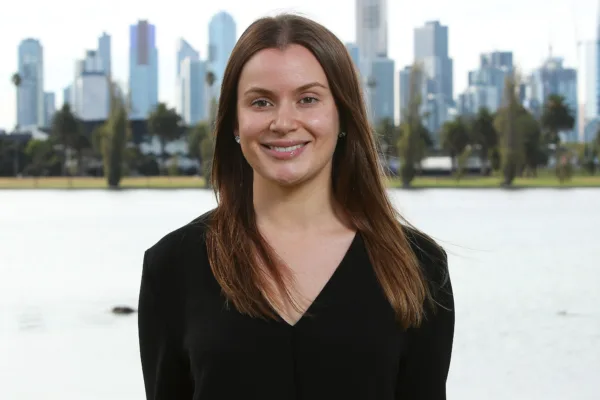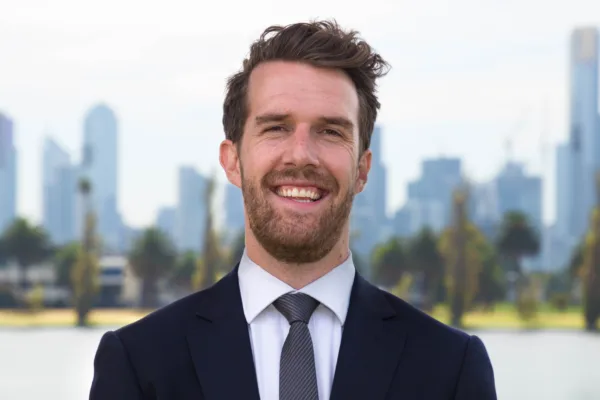The Engine Room: David Corrigan
Thursday, 22 October 2020
David has always been attracted to the behind-the-scenes, business world of sport.
‘The Engine Room’ aims to build the profile of Australian Grand Prix Corporation (AGPC) staff members and provide interesting insights into what it is like to be part of the team working on two iconic international events, the Formula 1® Australian Grand Prix in Melbourne and the Australian Motorcycle Grand Prix in Phillip Island.
David Corrigan - Senior Manager, Motorsport
1. You’ve had over 10 years’ experience working in the sport industry, what is it about the industry that you are so passionate about?
I feel extremely lucky to have been working in the sport industry for so long. Growing up in country Victoria, I played and watched a lot of sport as a young kid, so that was essentially my foundation of my passion for the industry.
The younger version of me wanted to be the next James Hird (on the field), however I was always attracted to the behind-the-scenes, business world of sport.
I think what really led me to follow my passion, was the support of my parents. They were always very encouraging and allowed me to follow my dreams and I knew at a young age that I wanted to develop and improve the sporting industry.
I certainly respect the high-end level of professional sport, however I would say that my passion has always been not only the growth of sport in Australia, but also the development of young sportspeople. I believe our country excels in supporting grassroots sport and establishing that pathway to the highest level.
My career so far has been extremely rewarding – most days are very different, throwing up different challenges, which I thrive on, however the people that I work with make it fun.
2. Prior to working at AGPC, you worked at Motorsport Australia (formally CAMS) for nearly five years, what’s your favourite memory of Australian motorsport during your time in the motorsport industry?
I have very fond memories of my time at Motorsport Australia – it was my first job in motorsport, and I am very thankful for the opportunity that it gave me. As the governing body, Motorsport Australia have a huge responsibility in maintaining a high level of safety standards, but they also do a fantastic job of improving the sport at all levels.
I remember in my first year, I was genuinely impressed by the level of focus and the continued development of the sport, so I guess my favourite memory is being part of that team.
Growing up, I wouldn’t say that I watched a huge amount of motorsport – I was always playing or watching cricket and football. Nevertheless, of course I remember, Michael Schumacher was always the household name in Formula 1®, the Holden versus Ford rivalry in the V8 Supercars was stronger than ever. I can honestly say that since my very first day at Motorsport Australia, I have grown to be so passionate about the sport.
Initially my role included managing Victorian car clubs, building grassroots participation, and then later in my career I was involved in the introduction and management of the Australian Formula 4 program. I was lucky to see firsthand the next generation of Australian motorsport talent rise through the ranks, some of whom are now racing at the professional elite level.
The pathway to the top is so tough for these young boys and girls – together with a lot of talent, it requires a huge financial investment, but also an in depth knowledge of the business side of the sport to generate interest from sponsors. They’re incredibly articulate and smart young sportspeople, which is pretty special.
3. The Formula 1® Australian Grand Prix boasts more on-track activity than any other F1® event in the world, why do you think there is such a strong appetite from fans?
It’s no secret that as Australians, we love our sport. Fundamentally, we’re in the business of entertainment, but the fans that attend both the Australian Formula 1® and Motorcycle Grands Prix are so loyal and passionate, so it’s our job to deliver a jam-packed, exciting on-track program.
Majority of what you see on-track stems from research and feedback from our fans, and when you have a strong contingent of support categories in Australia, it definitely helps! From open-wheeled categories and tin tops, to our premier national category, the Australian Supercars and our long-standing partnership with Porsche Carerra Cup who have a huge following, we’re very lucky to have such a variety of classes.
Not only does it come back to the fans, but being a four-day event, the Formula 1® Australian Grand Prix is a fantastic way for national categories to showcase themselves on the global stage. Combine that with the off-track food and music offering, the event caters for a diverse demographic and varying wants and needs. I love that when you walk around the circuit, you can spot the diehard motorsport fans just by what they’re wearing, whether it’s a cap or t-shirt, the fans come to our event to support their favourite driver or team and it’s just great to see.
4. The Australian Formula 1® and Motorcycle Grands Prix sees many young motorsport drivers compete on the global stage – particularly in support categories – what broader role does the event play in inspiring the next generation?
Like a lot of sports, Australia produces some amazing young athletes, and the Formula 1® and MotoGP™ events give them the platform to compete in front of a large audience they would not normally experience, and it is always great to see the next generation competing in our support categories.
Motorsport is very inclusive, and our events also play a big role in promoting female participation and in collaboration with Motorsport Australia who manage the program, AGPC are a proud supporter of the FIA Girls on Track Program that inspires and supports young females to pursue a career in the motorsport industry. There are many talented young females competing in Australia and overseas, and the FIA are doing some amazing work in developing programs to promote and support females in motorsport, and our events provide the perfect platform to highlight the great work being done in this space.
Off the track, our events also provide a number of opportunities to inspire the next generation. Motorsport really does play a huge role in developing young aspiring engineers through the AGPC Driving Learning education program with a STEM (science, technology, engineering and maths) focus to empower students to learn new skills, to succeed in the technical areas of Formula 1®, as well as the broader local Australian motorsport industries.
5. If you could change one engineering feature or race rule across Formula 1® or MotoGP, what would it be?
Great question and I wouldn’t know where to start! But as a sports fan, I ultimately want to see the best drivers and riders winning, but also witness a great race at the same time with plenty of overtaking and the occasional minor spinout because they are pushing themselves and the machine to the very limit. But as we have seen in Formula 1®, the Mercedes team has been the team to beat for a long time now – and in MotoGP™, Marquez has won the last four championships, although unfortunately the run of championship wins for Marquez will come to an end this year due to an injury he sustained earlier in the season.
I’m excited to see that the FIA have approved a new set of technical regulations, however due to the interrupted season this year the regulations will be introduced in 2022. The new rules will see new Formula 1® car designs, bigger tyres, and newly designed aerodynamics. It’s designed to create more exciting and closer racing – to ultimately see the best driver win and the opportunity for smaller teams to compete for the championship. Further to this, for the first time In Formula 1® history, there will be financial regulations – with Formula 1® teams agreeing to a (USD) $145mil cost cap to promote the competitive balance of the Championship, bridge the gap and promote sporting fairness, which will ensure Formula 1® teams are financially sustainable long-term.
6. You’ve recently completed your MBA studies, how do you apply your learnings to your role?
It has been a great career boost, it took me a few years as I studied part-time, it was time consuming and challenging, but I really enjoyed the experience.
I have recently joined the AGPC’s newly formed Senior Leadership team, and I’m confident that my studies have helped me grow and build a level of confidence when tackling the more complex business issues. It has also given me a greater understanding of what a productive leader is all about and applying all those skills to my work to create value for AGPC. I have a keen interest in the business side of sport so I am looking forward to the challenge – our main focus is to create value across the business in a variety of areas. AGPC has such a smart and passionate group of people and myself and the Senior Leadership team are really keen to start making a positive impact.
We have such a talented group of dedicated and passionate individuals who work at AGPC, so while I’m able to apply my prior learnings, I’m also able to learn a lot from my peers. Our CEO, Andrew Westacott leads from the front and really encourages strategic thinking and innovation, so we are continually exploring ways to improve our culture as business and also create and deliver two of the world’s best major sporting events on the international circuit. With that goal in mind, also comes the responsibility to provide our fans with best events and memorable experiences.




